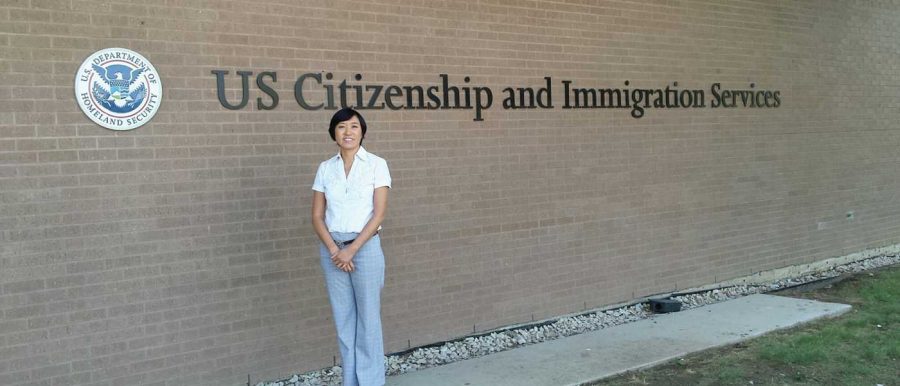Faculty members are in the progress of getting their citizenship.
Upper School Chinese teacher Petra Lynch waited as officials checked her identification and certifications. After entering the U.S. Citizenship and Immigration Services building in Irving and walking into a hall filled with people from over 40 different countries, Lynch sang the American national anthem, raised her right hand and swore an oath. Finally, on Sept. 11, 2015, after three years as a United States resident, Lynch stood and received applause as a citizen of the United States of America.
Lynch’s journey toward citizenship started in 2008, which permitted her to legally work and reside in the United States. Residents with green cards are required to pay taxes, but only American citizens have the right to vote.
“I think it is a natural process,” Lynch said. “Once you have a green card, then the next and the final step is citizenship. I think that everybody would go to that stage to get their citizenship.”
Despite getting her green card in 2008, Lynch and her husband of 17 years, John, decided to move from Taiwan in 2012 to permanently reside in the United States. Because her husband was already an American citizen, Lynch was required to wait three years until she could shift from being a green card holder to a full citizen.
Applying for the Green Card
Originally from Guanajuato, Mexico, Hockaday maintenance staff and athletic coach Victor Torres came to America 15 years ago.
Torres and his wife, Maria Torres, had to reapply every year to get their U.S. visas renewed because they did not hold green cards at that time. Visa holders, depending on their type of visa, have to reapply in order to stay in the United States legally.
“Every year we were concerned about whether they would give us a new visa or we would be rejected. If they said no, we would have to go back to Mexico,” Torres said.
In contrast, green card holders are legal residents and do not need to reapply. Torres first applied for his citizenship after holding a green card for five years.
Upper School Spanish Teacher Alejandra Suarez and her family immigrated to the United States from Mexico in January 2007 with a work visa. The visa permitted only Suarez’s husband, Omar Trevino, to work and did not allow them to become lawful permanent residents of the United States.
“We didn’t know if we were going to stay or not. The plan was to be here for three years,” Suarez said. “We thought that if it worked, we were going to stay and raise our children here.”
In September 2011, after negotiating with the company and hiring a lawyer to get their green cards, Suarez and her husband got a call from their lawyer that almost permanently halted their efforts. Immigration had lost their case.
“My husband and I sat down and wondered if we should start over and hire a new lawyer or take our chances and pay the $5,000 [to their current lawyer] and cross our fingers,” Suarez said. “We did pay the $5,000 and I got my residence.”
Suarez and her family received their green cards in 2011, but they have to wait five years until they are eligible to apply for their citizenship. That will be in October 2016.
From Resident to Citizen
The required time of permanent residency to qualify for citizenship depends on the type of green card; Lynch only had to reside in America for three years while Suarez had to be a resident for five.
Lynch went through a simple process. After her three years as a green card holder, Lynch sent in a citizenship application along with $680 to U.S. Citizenship and Immigration Services. Once the application was processed, she went in for fingerprinting and had a background check made by Homeland Security. Six months later, Lynch was eligible for an interview.
“In the interview, they ask you about 100 questions that range from government, history, civil questions and geography,” Lynch said.
After passing the citizenship exam, Lynch was officially an American citizen.“This country offers a different opportunity from the opportunity that my country gave me,” Lynch said. “That is what I cherished the most, the opportunities.”
Proud to be an American
Lynch is already eligible to vote in the United States; both Suarez and Torres hope to be eligible to vote in the next presidential election in November 2016.
One of the most controversial issues of this presidential election are the candidates’ views on immigration. Republican candidate Donald Trump and his plan to build “The Great Wall of Trump” along the Mexico-U.S. border have been in the headlines for the past few months.
“I find it very uneducated when he refers to immigration and building the big wall. It is not with walls that we grow as people,” Suarez said.
According to Torres, there needs to be a shift in perspective about the intentions of immigrants.
“I tell my kids that we have a lot on our shoulders. When people see us, they think, ‘Oh, they just mow the lawn or they just do the dishes,’” Torres said. “We need to change that through education and show people that we are different.”
Currently, neither Suarez, Lynch nor Torres know who they are going to vote for in the election. Despite this, they are all very adamant about finally exercising their right to vote as a way to give back to the United States. \
“I look forward to giving back and to keep giving back to the country that has opened its arms to us,” Suarez said. “You can ask my children; we love Mexico and we love our Spanish heritage, but the United States has given us so much.”














